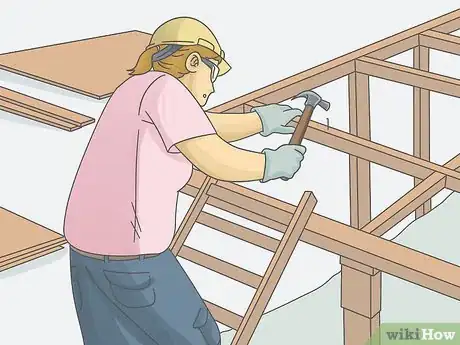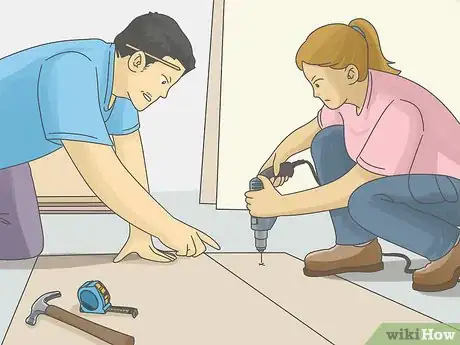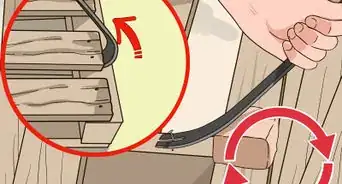This article was co-authored by Sam Hubbard and by wikiHow staff writer, Sophia Latorre. Sam Hubbard is a Professional Carpenter and the Owner of Hubbard Carpentry and Remodeling. He has over 19 years of experience in the industry. Sam specializes in kitchen remodels, home woodworking, cabinetry, and handyman services.
There are 8 references cited in this article, which can be found at the bottom of the page.
wikiHow marks an article as reader-approved once it receives enough positive feedback. In this case, 97% of readers who voted found the article helpful, earning it our reader-approved status.
This article has been viewed 75,328 times.
Whether you want to become a professional carpenter or simply build items for personal use, learning carpentry skills is the first step. Start by building up foundational skills and learning how to use hand and power tools. For a more in-depth approach, take some courses in carpentry or even earn a degree. To gain relevant experience, volunteer for a building organization, work on a construction crew, or become a carpenter’s apprentice. Remember that carpentry is physically demanding work and always take the necessary precautions to keep yourself, and those around you, safe.
Steps
Building Foundational Knowledge
-
1Brush up on your math skills. Math is an important part of carpentry, especially geometry. If you struggle with math, get a tutor, take a course online or at a community college, or work independently to strengthen your skills.
- There are a lot of great online math tutorials that walk you through how to solve problems step by step.
-
2Read books and trade journals about carpentry. If you’re new to carpentry, reading books, magazines, and journal articles can introduce you to the subject and teach you about basic skills as well as new industry developments. Search online or visit your local library to find relevant publications.[1]
- It also helps to read about architecture, especially if it covers the classical tradition.
Tip: Carpenter Magazine, Professional Builder Magazine, Basic Building and Construction Skills: Carpentry & Other General Construction Trades, and Complete Book of Framing: An Illustrated Guide for Residential Construction are great places to start!
Advertisement -
3Watch online tutorials to see how projects are completed. YouTube has tons of videos that will walk you through any carpentry project, from learning how to measure wood to building a shed. Search for the skill or project you want to learn and browse through the videos on the topic.
- Look for videos made by licensed carpenters to ensure the information they provide is both safe and accurate!
-
4Become familiar with hand and power tools. Carpenters use a variety of tools to manipulate wood but measuring tapes, squares, and levels are essential for nearly every project. Practice using a hammer, drill, nail gun, wood plane, and chisel as well.
- Additionally, learn how to use a variety of saws (such as a hand saw, table saw, circular saw, band saw, and coping saw) so you can cut wood to any specification.
Taking Carpentry Courses
-
1Enroll in a shop class in high school if you’re still a student. In an introductory course like this, you’ll learn safety procedures, how to measure and cut wood, and how to use basic hand and power tools. You might even learn how to read building plans! Not only will you gain valuable skills, but this can also help you decide if carpentry is a career path you want to explore.
- Depending on your school, the class might be called “shop,” “woodworking,” “fundamentals of construction,” or “carpentry basics.”
- You will need a high school diploma or GED to become a professional carpenter.
Tip: In addition to traditional carpentry classes, classes in blueprint reading, drafting, math, and fine woodworking can help you with your carpentry skills.[2]
-
2Take a carpentry class at a community college to learn the basics. Many community colleges offer courses in carpentry that you could take on nights or weekends, so this is a good option if you already have a full-time job. These types of classes introduce you to the basics, such as safety procedures (including OSHA (Occupational Safety and Health Administration) regulations), terminology and materials, how to use carpentry tools and equipment, and how to read blueprints.[3]
- You can continue on to advanced courses, such as in framing and building construction.
- Typically, you’ll earn a certificate for completing one of these courses, which is a great addition to your resume!
- If you want to learn a specific skill or build a specific structure (like a shed), look for specialty classes that will teach you how to do so.
-
3Obtain a degree in carpentry to get an edge over the competition. While you don’t have to have a degree to become a carpenter or complete projects for personal use, it’s the best way to gain knowledge and experience in the industry. Vocational schools are more likely to offer this degree than traditional universities—just make sure the school you choose is accredited so that your degree will be recognized and respected.[4]
- Alternatively, you can major in construction with a concentration in carpentry.
Gaining Experience
-
1Volunteer for a community carpentry project if you don’t have much experience. Volunteering for a charitable organization that builds houses can help you learn carpentry skills in exchange for your labor. Find the website of an organization near you, such as Habitat for Humanity, and search for volunteer opportunities coming up. Reach out to the volunteer coordinator and commit to helping with a project in your area.[5]
- Even if you don't know anything about carpentry, many community organizations that build houses will gladly have you help and learn along the way.
-
2Work as a construction laborer to learn from other carpenters. Working as a day-laborer or even as a part of a construction crew is a great way to gain some experience in this field. You’ll work alongside more experienced carpenters, which can help you expand your knowledge base and skill set. You don’t generally need any previous experience, but you may need to provide your own safety gear (such as a vest, hardhat, gloves, and goggles) as well as some basic tools (like a toolbelt, measuring tape, hammer, and so on).[6]
- Reach out to a labor company or temp agency in your area to learn more about available positions in this industry.
-
3Become an apprentice if you want to have a career in carpentry. If you plan to become a professional carpenter, you’ll need to complete an apprenticeship. Depending on where you live, this could entail a rigorous 4-year program or a less formal opportunity to work under a journeyman carpenter.[7]
- You’ll learn skills including reading blueprints, framing, welding, scaffold design, and fabrication.
Tip: In some cases, you will only need to pass your apprenticeship classes to start working as a journeyman carpenter. However, in other areas you will also need to pass a state or county licensing exam to get certified as a carpenter.
References
- ↑ https://libguides.greenriver.edu/c.php?g=565119&p=3892484
- ↑ https://apps.il-work-net.com/cis/clusters/OccupationDetails/100265?parentId=110200§ion=courses§ionTitle=Helpful%20High%20School%20Courses
- ↑ https://www.delmar.edu/continuing-education/carpentry_training_program.html
- ↑ https://files.eric.ed.gov/fulltext/ED529172.pdf
- ↑ https://www.habitat.org/volunteer
- ↑ https://www.bls.gov/ooh/construction-and-extraction/construction-laborers-and-helpers.htm
- ↑ https://www.nwci.org/apprenticeship/
- ↑ https://youtu.be/a6oG_6MVE_I?t=102



































































